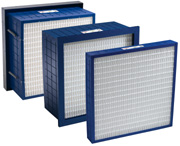
Shane Tincher
With regard to energy savings, HVAC systems are a key component and opportunity to save money. According to the U.S. Department of Energy (DOE), HVAC accounts for 40-60 percent of the energy used in U.S. commercial and residential buildings. Additionally, the DOE 2003 Buildings Energy Databook reports that these commercial and residential buildings account for 39 percent of total energy consumption in the U.S. With most of the concentration being on boiler and chiller plant improvements, building automation, electricity peak shaving, lighting, windows, water system conservation, and alternate energy sources, to name a few, an often overlooked energy conservation measure is choosing the best air filter for the HVAC system.

Figure 1. System A filter.
AIR FILTRATION AND RESISTANCE
Air filtration not only contributes to overall indoor environmental quality, but also greatly contributes to airflow resistance before the coil. If we know that air filtration prevents fouling of the coil, then we know that the importance of the right air filter in terms of efficiency (to protect the coil) and resistance will go a long way in improving the operational efficiency of the HVAC system, and substantially affecting energy consumption. While many organizations focus on filter price in an effort to decrease the budget, the more appropriate target may be to focus on filter performance in an effort to make a substantial impact on reducing the energy budget (a much larger percent of operating dollars). However, it seems largely misunderstood just exactly how air filtration can play a role in energy savings. A quantification of this impact quickly shows that the savings can be huge when choosing the right air filtration product.The purpose of this comparison is to save energy dollars by evaluating the HVAC system with regard to energy use and air filtration. In the air filtration industry, we know that greater dust holding capacity and lower resistance equals longer filter life in the system. We also know that energy cost (and not the initial purchase price) is the real cost of air filtration. By choosing an air filter that utilizes technological advancements in the air filtration industry to increase or upgrade to a higher MERV-rated filter, lower the initial resistance, maintain current dust holding capacity, and increase the life of the filter in the system, we win in energy savings, indoor air quality, and overall money savings.

Figure 2. System B filter.

Table 1. Comparison of a MERV 15 and a MERV 14 filter. (Courtesy of Keith Chesson, technical services manager for CLARCOR Air Filtration Products.)
ENERGY SAVINGS CALCULATION
Table 1 compares a MERV 15 filter with a MERV 14 filter. Each filter has a distinctly different initial cost and resistance, but the same final resistance, system information, and energy cost. The impact that produces the energy savings results that we seek can be noted in the Energy Cost per Changeout ($) in the table below. Note that System A uses a new technology filter (Figure 1) that is made from high-strength, high-impact polystyrene plastic and incorporates adhesive separators; so it has no metal components in order to make it a lower cost to manufacture (thus, the lower end-user cost for higher MERV in comparison to the System B filter shown in Figure 2).Very simply, System A using the higher efficiency filter offers the 13 percent savings noted above thanks to the lower initial resistance (0.35 in. wg vs. 0.64 in. wg) and lower overall energy consumption (3,174 kWh vs. 3,671 kWh). While having a lower price helps, the real impact on savings comes from energy.
Additional indirect benefits of this project are that we understand our HVAC system better than before. We notice more areas for improvement, such as the need for caulking and sealing of “air bypass” areas within the HVAC envelope. We also begin (or continue) to review the calibration of our HVAC controls, monitoring software, labor costs for maintenance, and commissioning documents (review if applicable). We are making a solid commitment to our company/customer with regard to understanding and being proactive about the impact of energy consumption on operating profit. Finally, we build a benchmark for others (internal and external) as we “carry the torch” in energy conservation and sustainability efforts.



